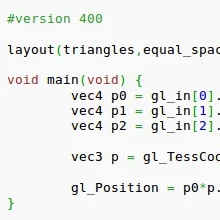OpenGL 3.1 Released Plus New Audio Standard

The OpenGL 3.1 specification also updates the GL Shading Language to GLSL version 1.40. OpenGL 3.1 introduces texture buffer objects, signed normalized textures, uniform buffer objects, more samplers, primitive restart, instancing, and a CopyBuffer API. In particular, the CopyBuffer API will be important when sharing buffers between OpenGL and OpenCL. In regards to OpenCL, Khronos also let loose that OpenCL implementations should begin appearing quite soon.
The OpenGL 3.1 specification can be downloaded on the Khronos web-site. The press release announcing the OpenGL 3.1 specification release can be found in their news room.
The proprietary Linux drivers from AMD/ATI and NVIDIA support OpenGL 3.0 and in due time we expect these drivers to support OpenGL 3.1 as well. The proprietary S3 Graphics driver also supports OpenGL 3.0. Sadly, none of the open-source Linux graphics drivers currently support OpenGL 3.0 / GLSL 1.30. We will likely not see this support added until Gallium3D is ready to enter the spotlight. By the time there is full Mesa / Gallium3D support for OpenGL 3.0/3.1, we sadly expect OpenGL 3.2 to be out in the wild.
Besides announcing OpenGL 3.1, the Khronos Group also announced the release of OpenSL ES 1.0. OpenSL ES is yet another open, industry standard. OpenSL ES aims to provide a specification for mobile and embedded audio processing. OpenSL ES 1.0 is described as "a royalty-free, cross-platform C-language API for high-performance, low-latency audio functionality on mobile and embedded devices." Among the features of the OpenSL ES 1.0 specification are full 3D positional audio including grouping of 3D sound sources and optional support for LED and vibrator controls. The OpenSL ES 1.0 specification can be read here with its press release here.
Lastly, the Khronos Group is beginning work on yet another standard. The newest standard they'll be tackling is an API for accelerated 3D on the web. Mozilla, Google, and others are working with the Khronos Group on a way to expose OpenGL and OpenGL ES 2.0 within the web-browser.
27 Comments

